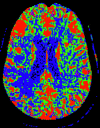Effect of training and experience on qualitative and quantitative CT perfusion data
- PMID: 17353307
- PMCID: PMC7977860
Effect of training and experience on qualitative and quantitative CT perfusion data
Abstract
Background and purpose: To evaluate interobserver reliability of obtaining CT perfusion (CTP) data for qualitative identification of perfusion abnormality and quantitative assessment through regions-of-interest (ROIs) placement.
Materials and methods: Six observers participated in the study (neuroradiology attending physician, neurology attending physician, neuroradiology fellow, radiology resident physician, senior and junior CT technologists). After a brief training session, each observer evaluated 20 CTP datasets for qualitative identification of a right- or left-sided perfusion abnormality or symmetric perfusion. Observers also placed a single ROI of standard size to obtain quantitative data on the most severely hypoperfused region. An additional 10 ROIs were placed on the cortex to quantitatively evaluate global cortical perfusion. Mean quantitative cerebral blood flow (CBF), cerebral blood volume (CBV), and mean transit time (MTT) values were analyzed.
Results: The kappa values for qualitative assessment of a perfusion abnormality ranged from 0.55 to 1.0. Coefficients of variation for quantitative assessment of ischemia/infarct region were 27.10% for CBF, 13.33% for CBV, and 4.66% for MTT. Coefficients of variation for quantitative assessment of global cortical perfusion were 11.88% for CBF, 13.66% for CBV, and 3.55% for MTT. The junior CT technologist and neuroradiology fellow showed significant differences compared with other observers for the ischemia/infarct region and global cortical perfusion, respectively.
Conclusion: Overall, quantitative differences seen in this study would not necessarily affect quality of interpretation of ischemia/infarct region or global cortical perfusion. Therefore, obtaining qualitative and quantitative CTP data can reliably be performed in the clinical setting among observers with various levels of skill and experience when using a uniform and standard technique.
Figures
Similar articles
-
Reproducibility of postprocessing of quantitative CT perfusion maps.AJR Am J Roentgenol. 2007 Jan;188(1):213-8. doi: 10.2214/ajr.05.2188. AJR Am J Roentgenol. 2007. PMID: 17179367
-
Assessment of the reproducibility of postprocessing dynamic CT perfusion data.AJNR Am J Neuroradiol. 2004 Jan;25(1):97-107. AJNR Am J Neuroradiol. 2004. PMID: 14729537 Free PMC article.
-
Automated versus manual post-processing of perfusion-CT data in patients with acute cerebral ischemia: influence on interobserver variability.Neuroradiology. 2009 Jul;51(7):445-51. doi: 10.1007/s00234-009-0516-9. Epub 2009 Mar 10. Neuroradiology. 2009. PMID: 19274457 Free PMC article.
-
Cerebral perfusion CT: technique and clinical applications.Radiology. 2004 Jun;231(3):632-44. doi: 10.1148/radiol.2313021488. Epub 2004 Apr 29. Radiology. 2004. PMID: 15118110 Review.
-
[Cerebral perfusion CT: theoretical aspects, methodical implementation and clinical experience in the diagnosis of ischemic cerebral infarction].Rofo. 2000 Mar;172(3):210-8. doi: 10.1055/s-2000-109. Rofo. 2000. PMID: 10778450 Review. German.
Cited by
-
Clinical utility of quantitative imaging.Acad Radiol. 2015 Jan;22(1):33-49. doi: 10.1016/j.acra.2014.08.011. Epub 2014 Oct 22. Acad Radiol. 2015. PMID: 25442800 Free PMC article. Review.
-
Education Research: Neuroradiology Curriculum and Competencies Among Canadian Adult Neurology Residency Programs: A Cross-Sectional Study.Neurol Educ. 2023 Nov 6;2(4):e200096. doi: 10.1212/NE9.0000000000200096. eCollection 2023 Dec 22. Neurol Educ. 2023. PMID: 39359313 Free PMC article.
-
Cerebral vasospasm and hypoperfusion after traumatic brain injury: Combined CT angiography and CT perfusion imaging study.Surg Neurol Int. 2021 Jul 19;12:361. doi: 10.25259/SNI_859_2020. eCollection 2021. Surg Neurol Int. 2021. PMID: 34345501 Free PMC article.
-
Functional CT of squamous cell carcinoma in the head and neck: repeatability of tumor and muscle quantitative measurements, inter- and intra-observer agreement.Eur Radiol. 2008 Oct;18(10):2241-50. doi: 10.1007/s00330-008-0990-1. Epub 2008 Apr 30. Eur Radiol. 2008. PMID: 18446342
-
Standardization of Stroke Perfusion CT for Reperfusion Therapy.Transl Stroke Res. 2012 Jun;3(2):221-7. doi: 10.1007/s12975-012-0156-y. Epub 2012 Mar 28. Transl Stroke Res. 2012. PMID: 24323777
References
-
- Sanelli PC, Nicola G, Tsiouris AJ, et al. Reproducibility of postprocessing quantitative CT perfusion maps. AJR Am J Roentgenol 2007;188:213–18. - PubMed
-
- Sanelli PC, Deshmukh M, Ougorets I, et al. Safety and feasibility of using a central venous catheter for rapid contrast injection rates. AJR Am J Roentgenol 2004;183:1829–34 - PubMed
-
- Sanelli PC, Lev MH, Eastwood JD, et al. The effect of varying user-selected input parameters on quantitative values in CT perfusion maps. Acad Radiol 2004;11:1085–92 - PubMed
-
- Gillard JH, Antoun NM, Burnet NG, et al. Reproducibility of quantitative CT perfusion imaging. Br J Radiol 2001;74:552–55 - PubMed
Publication types
MeSH terms
LinkOut - more resources
Full Text Sources
Medical

